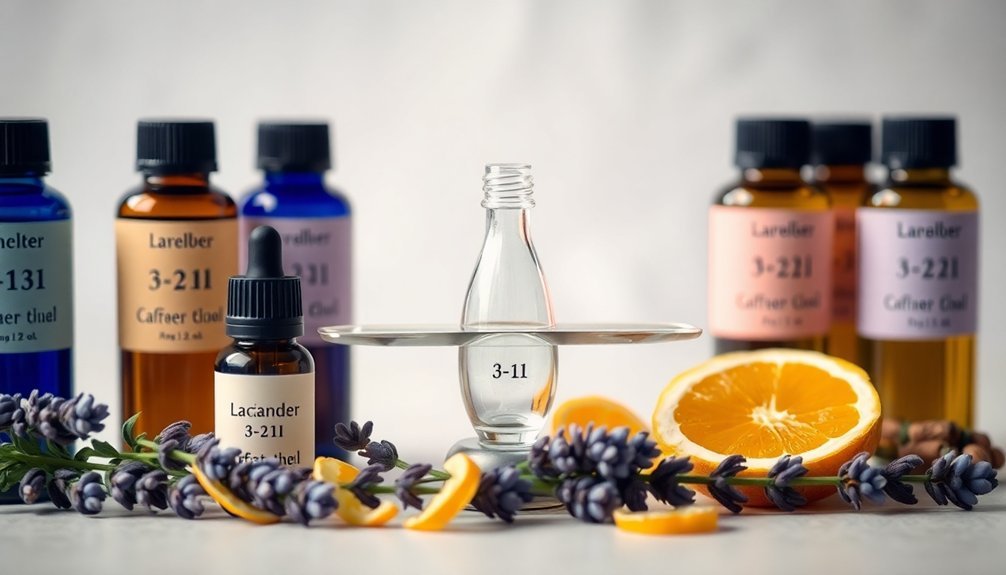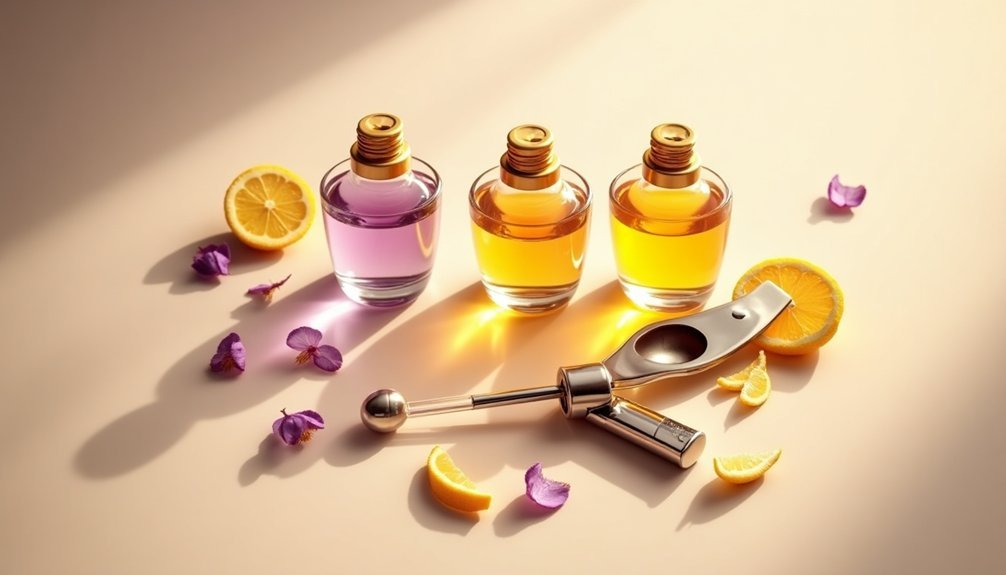You'll find five proven formulas to create balanced perfumes, starting with the classic 3-2-1 ratio that uses three parts top notes, two parts middle notes, and one part base notes. For floral blends, try bergamot and orange tops with rose middle notes. Woody orientals work well with a 20-40-50 split, while vanilla-based scents follow a 30-50-20 structure. Herbal essences shine with a 20% essential oil blend. These basic ratios open the door to endless fragrance possibilities.
Classic 3-2-1 Ratio For Beginners

When creating your first DIY perfume, the classic 3-2-1 ratio provides a reliable foundation for balancing fragrance notes.
You'll use three parts top notes, which deliver the initial burst of scent through ingredients like citrus and mint. These fleeting aromas will set your perfume's first impression but fade within 30 minutes.
Add two parts middle notes, such as florals or spices, to form your fragrance's heart. These notes bridge the gap between top and base notes, lasting several hours while giving your perfume its distinctive character.
Finally, include one part base notes using rich ingredients like myrrh or vanilla. These deep aromas emerge after 30 minutes and act as anchors, providing longevity and stability to your blend. Jojoba wax as carrier helps extend the fragrance's duration while being gentle on skin.
While this ratio isn't set in stone, it's an excellent starting point for balanced perfumes.
Fresh Floral Formula With Citrus Notes
To create a vibrant fresh floral perfume, you'll need to carefully balance bright citrus notes with delicate florals. A harmonious blend starts with bergamot and orange in the top notes, shifts through rose and geranium in the heart, and settles into a sophisticated base of vetiver and musk. The combination creates a long-lasting diffusive effect similar to what you'd experience with ambrettolide and coumarin in traditional compositions.
| Note Level | Essential Components |
|---|---|
| Top Notes | Bergamot + Orange |
| Middle Notes | Fresh Rose + Geranium |
| Bridge Notes | Green Tea + Cyclabute |
| Base Notes | Vetiver + Musk |
| Enhancers | Benzoin + Hedione |
Try combining these elements in a 3-2-1 ratio, with three parts top notes, two parts middle notes, and one part base notes. You'll find the citrus brightens the florals while the musk and vetiver provide lasting depth. Add small amounts of benzoin to smooth any sharp edges in your composition.
Woody Oriental Blend Measurements

Moving from fresh florals to deeper territory, woody oriental blends demand precise measurements for a rich, sophisticated result.
You'll want to start with your top notes, using 20-40% of ingredients like saffron, violet, or bergamot to create that initial impression.
For the heart of your fragrance, allocate 50-75% to middle notes, incorporating sandalwood, vetiver, or patchouli. These'll provide the signature woody character and lasting depth.
Finally, round out your blend with 5-10% base notes, such as ambergris, musk, or vanilla. The resulting product should fill a 100ml volume for standard eau de toilette production.
Consider starting with a 3:2:1 ratio (top:middle:base) and adjust from there. Add ingredients drop by drop, testing as you go.
Don't forget to let your creation mature for several days to achieve the perfect harmony of notes.
Sweet Vanilla Base Proportions
Creating sweet vanilla-based perfumes requires a delicate balance of proportions to achieve the perfect harmony.
You'll want to start with vanilla as your foundation, typically using 5-10% of your total blend. Then, layer complementary scents while following standard perfume ratios like 30-50-20 or 40-50-10 for top, middle, and base notes respectively.
- Mix 3 drops of Madagascar vanilla with 2 drops of jasmine and 1 drop of citrus for a bright, sweet blend.
- Combine 2 drops of vanilla with 4 drops of rose and 1 drop of bergamot for a floral sweetness.
- Blend 4 drops of vanilla with 2 drops of sandalwood and 1 drop of lavender for a woody-sweet aroma.
Test each combination on your skin, adjusting proportions until you've found your perfect signature scent.
Herbal Essence Mix Calculations

While sweet vanilla blends rely on specific proportions, herbal essence perfumes demand precise mathematical calculations for ideal results.
For a 5ml herbal essence perfume, you'll need to follow a 30-50-20 ratio of top, middle, and base notes. Start by calculating 20% of your total volume for the essential oil blend, which equals 20 drops of fragrance oils to 80 drops of carrier oil.
For your herbal blend, use bright top notes like mint or eucalyptus, followed by lavender or geranium for the middle notes, and ground it with patchouli or sandalwood base notes.
Measure each ingredient using a digital scale with 0.01g precision, and record every drop in your notebook. Let your blend mature for at least one week, testing periodically to ascertain the herbal notes harmonize properly.
Frequently Asked Questions
How Long Should I Let My Perfume Blend Mature Before Testing?
You'll need to let your perfume mature for at least 2-4 weeks, though complex blends may require 2-6 months. Start testing after the first month, but keep checking periodically as the scent develops.
Can I Substitute Synthetic Fragrances for Natural Essential Oils?
Yes, you can substitute synthetics for essential oils in your perfume. You'll get more consistent scents and longer-lasting fragrances, but you'll lose some of the therapeutic benefits and natural complexity of essential oils.
What Carrier Oils Work Best for Diluting Perfume Blends?
You'll get the best results using jojoba oil, which mimics skin's natural oils, or fractionated coconut oil for their stability. Sweet almond and grapeseed oils work well too, offering excellent absorption and longevity.
How Do Temperature and Storage Conditions Affect Perfume Note Ratios?
You'll notice higher temperatures make top notes evaporate faster, while cooler storage helps preserve base notes. Keep your perfumes in dark, consistent temperatures to maintain their intended ratios and overall balance.
Should Perfume Notes Be Adjusted Differently for Skin Versus Room Sprays?
Yes, you'll need different note ratios. For skin perfumes, use stronger base notes (30-40%) for longevity. For room sprays, emphasize top notes (40-50%) since they don't interact with skin chemistry.
In Summary
You've now learned five essential perfume formulas to create balanced fragrances at home. Whether you're starting with the basic 3-2-1 ratio or experimenting with complex herbal blends, remember to keep track of your measurements and trust your nose. Don't be afraid to adjust these ratios slightly to match your preferences. With practice and patience, you'll develop your signature scent using these foundational formulas.





Leave a Reply